Unit 3 Back to the past Grammar and usage(2)_ Subject-verb agreement 课件(20张)
文档属性
| 名称 | Unit 3 Back to the past Grammar and usage(2)_ Subject-verb agreement 课件(20张) | 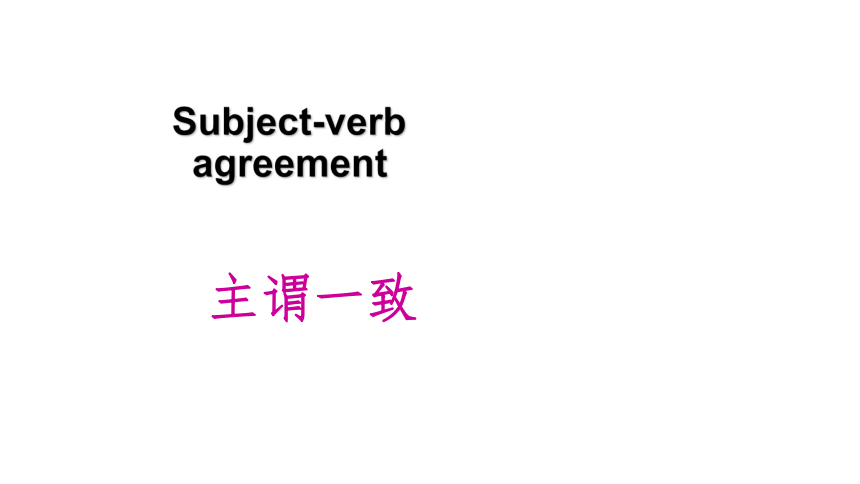 | |
| 格式 | zip | ||
| 文件大小 | 644.9KB | ||
| 资源类型 | 教案 | ||
| 版本资源 | 牛津译林版 | ||
| 科目 | 英语 | ||
| 更新时间 | 2019-07-24 22:17:44 | ||
图片预览

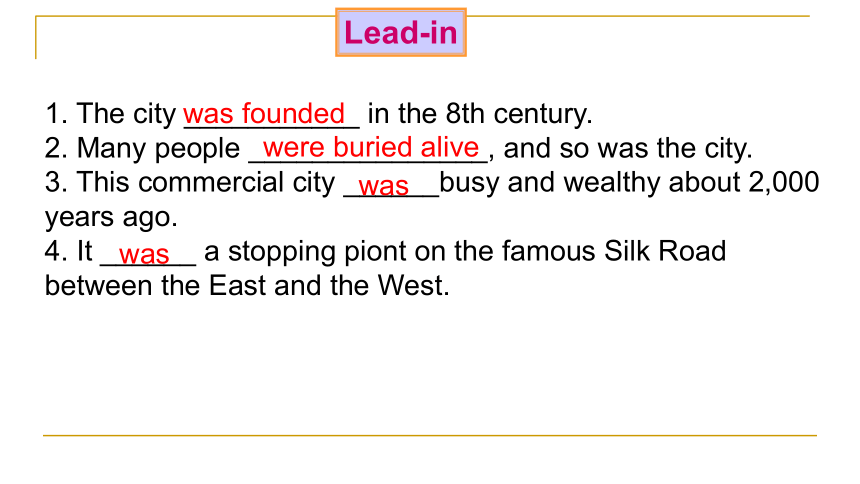

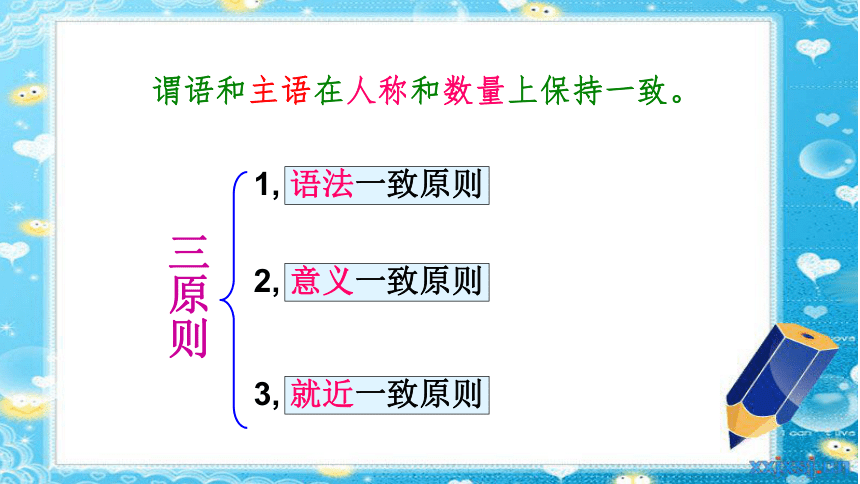
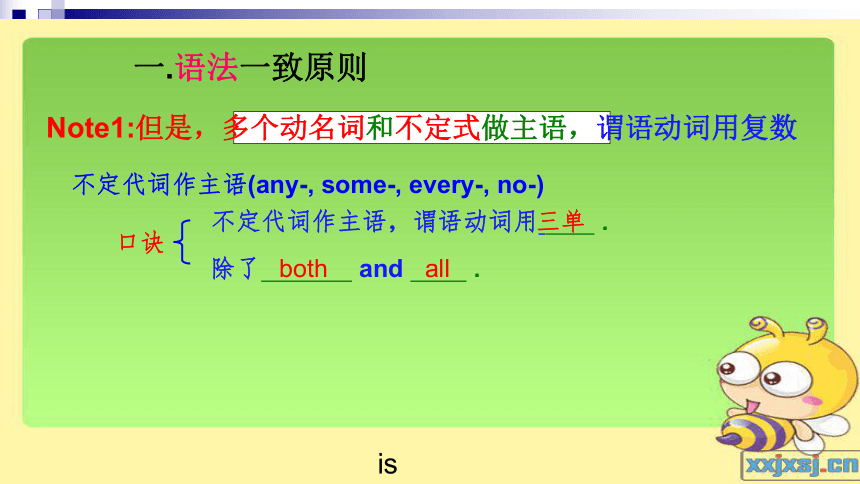

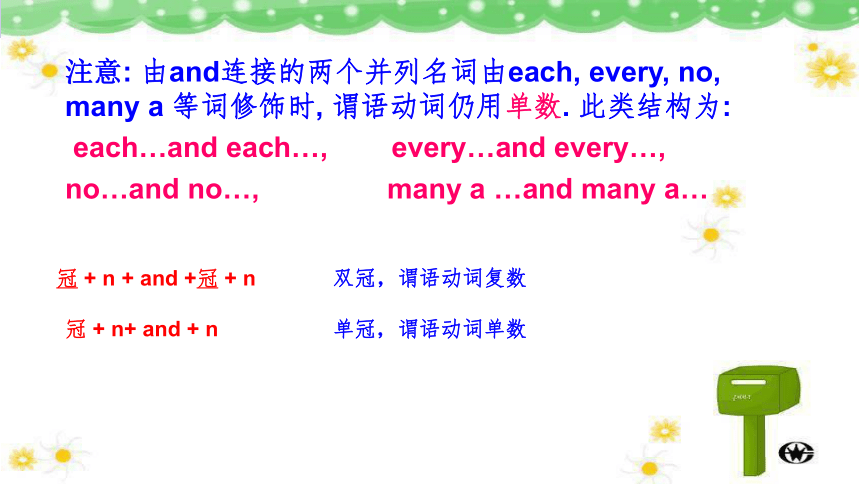
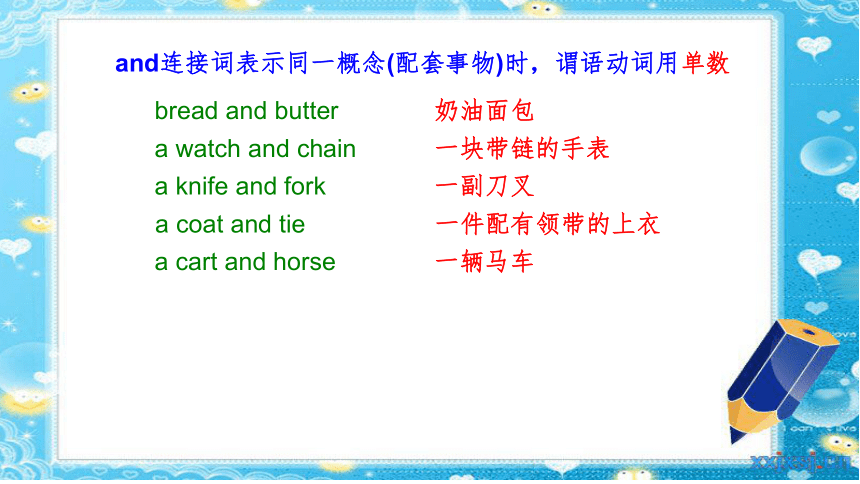
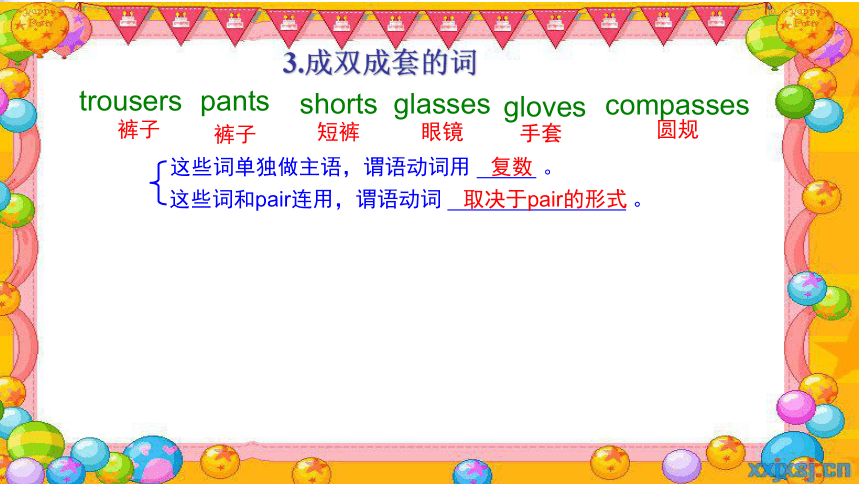
文档简介
课件20张PPT。Subject-verb agreement主谓一致Lead-in1. The city ___________ in the 8th century.
2. Many people _______________, and so was the city.
3. This commercial city ______busy and wealthy about 2,000 years ago.
4. It ______ a stopping piont on the famous Silk Road between the East and the West.was foundedwere buried alivewas was在英语句子里,谓语受主语支配,谓语动词必须和主语在人称和数量上保持一致,这就叫主谓一致主谓一致的定义谓语和主语在人称和数量上保持一致。1, 语法一致原则2, 意义一致原则3, 就近一致原则三原则不定代词作主语(any-, some-, every-, no-)口诀不定代词作主语,谓语动词用 .除了 and .bothall三单is一.语法一致原则Note1:但是,多个动名词和不定式做主语,谓语动词用复数more than a……:多于一…,不止一…more than one + 单n ,谓语动词用 .单数复数more than two + 复n ,谓语动词用 .不止一个不止两个,两个以上 many a + 单n许多 注意: 由and连接的两个并列名词由each, every, no, many a 等词修饰时, 谓语动词仍用单数. 此类结构为:
each…and each…, every…and every…,
no…and no…, many a …and many a…
冠 + n + and +冠 + n双冠,谓语动词复数冠 + n+ and + n单冠,谓语动词单数and连接词表示同一概念(配套事物)时,谓语动词用单数bread and butter奶油面包a watch and chain一块带链的手表a knife and fork一副刀叉a coat and tie一件配有领带的上衣a cart and horse一辆马车3.成双成套的词trouserspants裤子裤子shortsglasses短裤眼镜glovescompasses手套圆规这些词单独做主语,谓语动词用 。复数这些词和pair连用,谓语动词 。取决于pair的形式总结:
一.谓语用单数,当主语是:
1单数名语,不可数名词 2不定式,动名词, 从句
3不定代词(除both, all) 4a large quantity(amount) of +名词
5 many a /more than one + 名词
二, 谓语用复数, 当主语是:
1复数名词
2 由and或both…and连接并列主语时(and连接词表示同一
概念时; 由and连接的两个并列名词由each, every, no,
many a 等词修饰时)
3成双成套的词(如trousers, pants单独做主语时,谓用单数,
和pair连用时,谓取决于pair的形式)二,谓语动词根据中心词确定单复数形式,当主语是:
1.当主语后面接说明主语的修饰语, 如介词短语,谓语动词的单复数只看前面的主语(如with/together with)
2. 当pair of/ kind of/ type of/sort of等作主语时, 谓语动词与pair/kind/type/sort保持一致
3.当分数、百分数,数量+of+名词作主语时,谓语与该名词保持一致. (如the rest of, a part of)
4. 两个特殊的词: population, number
1) population 作主语时, 谓(单数)
分数等+population时, 谓(复数)
2) a number of +名词复数, 谓(复数)
the number of +名词复数,谓(单数)
1. All the professional personnel _____ invited to attend the meeting. A. have? ?B. were? ? C. has? ?D. was 2. Every doctor and every nurse ______ a new hospital for SARS patients. A. has founded? B. have found ? C. expects to found? D. has to be found 3. The number of students in this school ______. A. is increasing? B. are increasing? C. is increased? D. are increased 不定代词each, every, no所修饰的名词 及each…and each…, every…and every…,no…and no…, many a …and many a…结构作主语时,谓语动词仍用单数形式。_________________________________________5. You, who______ his good friend, should help him get out of trouble. A. am?? B. is? ?C. are?? D. was 6. A pair of shoes ______ under the bed. A. was ??B. were??C. has been? D. have been 7. Many a student ______ the film now. A. has seen?B. had seen?C. have seen?D. saw 4. The questions which ______ to yours are not easy to answer. A. is the same? B. are different? C. is like?? D. are similar DCAA_______________________如果主语有more than one… 或many a… 构成,尽管从意义上看是复数内容,但它的谓语动词仍然用单数形式。如:
8. A fork and knife ______ on the table. A. is? ?B. are?? C. has been? D. have been _____________________a watch and chain 一块带链的表? a needle and thread /a coat and tie 配有领带的上衣 A knife and fork is needed for a western meal. 吃西餐时要用刀和叉。 The cart and horse is coming. 马车来了。 (配套事物)意义一致原则要点总结一.时间,距离,金钱,度量衡
二. 书名,报刊名,戏剧句, 国家名
三. The + adj(一类人)
四. 集体名词
五.单复数形式相同的名词(如sheep deer)
就近一致原则总结
当用either … or、neither … nor、not only … but also… 、whether…or和not …but…连接句子主语时,采取 “就近原则”。(there be 句型也是就近原则)
2. Five minus three ______ two. A. is?? B. are?? C. was?? D. were 3. Twenty dollars ______ enough for the coat. A. is? ?B. are?? C. was?? D. were 1. The crowd ______ for their lives A. were run? B. were running? C. was run?? D. was running BAA当名词词组中心词为表示度量、距离、金额、时间等复数名词时,往往可以根据意义一致的原则,把这些复数名词看作一个整体,谓语动词用单数形式。____________________________________________4.The first two questions were easy, but the rest of them ______ not. A. was??B. were??C. being??D. to be 5.Either Tom or I ______ to blame. A. to be??B. am??C. are??D. is 6.______ good exercise. A. Climbing hills is?? B. Climbing the hill is C. The climbing hills are?? D. The climbing of hills are BBA 如果名词词组的中心词是all, most, rest, some, neither, none, no等词,所指是复数意义,谓语动词用复数形式;反之用单 数。如: 7. Something ______ gone wrong with my TV set. A. has??B. have??C. is??D. are 8. This is one of the best films that ______ this year. A. is appearing?? B. appear C. has appeared? D. have appeared 9. Half of the students ______ made the same mistake. A. has??B. have??C. is??D. are 10. The old ______ taken good care of in our country. A. is??B. has??C. are??D. have ADBC______________________ 关系代词which, who, that在定语从句中作主语时,其谓语动词的数应与其前的先行词 的数保持一致。 half of, (a) part of修饰可数名词单数及不可数名词作主语时,谓语动词用单数,修饰可数名词复数作主语时,谓语动词用复数。 ____________________________________“the+形容词(或过去分词或现在分词)”如:the brave, the poor, the rich, the blind, the young, the old, the sick, the wounded, the injured, the unemployed, the dying, the living 等结构担任主语表示一类人时,谓语动词常用复数形式;但也有少数的形容词或过去分词与定冠词连用指个别或表示抽象的概念时,谓语动词用单数。 11. Snow White and the Seven Dwarfs ______ popular with people of all ages since it was made into the first full-length cartoon. A. were??B. was??C. has been?D. is 12.All but one ______ here just now. A. is?? B. was??C. has been?D. were 13. Three-fourths of the surface of the earth ______ sea. A. is?? B. are?? C. were? D. has been 14. Nobody but Jane ______ the secret. A. knows?? B. know?? C. have known ? D. is known CDAA形复意单的单词有:news,works 和一些以s结尾的书名、组织机构的名称(如: “The Selected Poems of Li Bai”, the United States, the United Nations) 以及以ics结尾的学科名称(如:physics,politics,maths,economics等)。 当主语后面跟有as well as, as much as, no less than, along with, with, like, rather than, together with, but, except, besides, including, in addition to等引导的词组时,其谓语动词的单、复数按主语的单、复数而定。 _________________________________________________
2. Many people _______________, and so was the city.
3. This commercial city ______busy and wealthy about 2,000 years ago.
4. It ______ a stopping piont on the famous Silk Road between the East and the West.was foundedwere buried alivewas was在英语句子里,谓语受主语支配,谓语动词必须和主语在人称和数量上保持一致,这就叫主谓一致主谓一致的定义谓语和主语在人称和数量上保持一致。1, 语法一致原则2, 意义一致原则3, 就近一致原则三原则不定代词作主语(any-, some-, every-, no-)口诀不定代词作主语,谓语动词用 .除了 and .bothall三单is一.语法一致原则Note1:但是,多个动名词和不定式做主语,谓语动词用复数more than a……:多于一…,不止一…more than one + 单n ,谓语动词用 .单数复数more than two + 复n ,谓语动词用 .不止一个不止两个,两个以上 many a + 单n许多 注意: 由and连接的两个并列名词由each, every, no, many a 等词修饰时, 谓语动词仍用单数. 此类结构为:
each…and each…, every…and every…,
no…and no…, many a …and many a…
冠 + n + and +冠 + n双冠,谓语动词复数冠 + n+ and + n单冠,谓语动词单数and连接词表示同一概念(配套事物)时,谓语动词用单数bread and butter奶油面包a watch and chain一块带链的手表a knife and fork一副刀叉a coat and tie一件配有领带的上衣a cart and horse一辆马车3.成双成套的词trouserspants裤子裤子shortsglasses短裤眼镜glovescompasses手套圆规这些词单独做主语,谓语动词用 。复数这些词和pair连用,谓语动词 。取决于pair的形式总结:
一.谓语用单数,当主语是:
1单数名语,不可数名词 2不定式,动名词, 从句
3不定代词(除both, all) 4a large quantity(amount) of +名词
5 many a /more than one + 名词
二, 谓语用复数, 当主语是:
1复数名词
2 由and或both…and连接并列主语时(and连接词表示同一
概念时; 由and连接的两个并列名词由each, every, no,
many a 等词修饰时)
3成双成套的词(如trousers, pants单独做主语时,谓用单数,
和pair连用时,谓取决于pair的形式)二,谓语动词根据中心词确定单复数形式,当主语是:
1.当主语后面接说明主语的修饰语, 如介词短语,谓语动词的单复数只看前面的主语(如with/together with)
2. 当pair of/ kind of/ type of/sort of等作主语时, 谓语动词与pair/kind/type/sort保持一致
3.当分数、百分数,数量+of+名词作主语时,谓语与该名词保持一致. (如the rest of, a part of)
4. 两个特殊的词: population, number
1) population 作主语时, 谓(单数)
分数等+population时, 谓(复数)
2) a number of +名词复数, 谓(复数)
the number of +名词复数,谓(单数)
1. All the professional personnel _____ invited to attend the meeting. A. have? ?B. were? ? C. has? ?D. was 2. Every doctor and every nurse ______ a new hospital for SARS patients. A. has founded? B. have found ? C. expects to found? D. has to be found 3. The number of students in this school ______. A. is increasing? B. are increasing? C. is increased? D. are increased 不定代词each, every, no所修饰的名词 及each…and each…, every…and every…,no…and no…, many a …and many a…结构作主语时,谓语动词仍用单数形式。_________________________________________5. You, who______ his good friend, should help him get out of trouble. A. am?? B. is? ?C. are?? D. was 6. A pair of shoes ______ under the bed. A. was ??B. were??C. has been? D. have been 7. Many a student ______ the film now. A. has seen?B. had seen?C. have seen?D. saw 4. The questions which ______ to yours are not easy to answer. A. is the same? B. are different? C. is like?? D. are similar DCAA_______________________如果主语有more than one… 或many a… 构成,尽管从意义上看是复数内容,但它的谓语动词仍然用单数形式。如:
8. A fork and knife ______ on the table. A. is? ?B. are?? C. has been? D. have been _____________________a watch and chain 一块带链的表? a needle and thread /a coat and tie 配有领带的上衣 A knife and fork is needed for a western meal. 吃西餐时要用刀和叉。 The cart and horse is coming. 马车来了。 (配套事物)意义一致原则要点总结一.时间,距离,金钱,度量衡
二. 书名,报刊名,戏剧句, 国家名
三. The + adj(一类人)
四. 集体名词
五.单复数形式相同的名词(如sheep deer)
就近一致原则总结
当用either … or、neither … nor、not only … but also… 、whether…or和not …but…连接句子主语时,采取 “就近原则”。(there be 句型也是就近原则)
2. Five minus three ______ two. A. is?? B. are?? C. was?? D. were 3. Twenty dollars ______ enough for the coat. A. is? ?B. are?? C. was?? D. were 1. The crowd ______ for their lives A. were run? B. were running? C. was run?? D. was running BAA当名词词组中心词为表示度量、距离、金额、时间等复数名词时,往往可以根据意义一致的原则,把这些复数名词看作一个整体,谓语动词用单数形式。____________________________________________4.The first two questions were easy, but the rest of them ______ not. A. was??B. were??C. being??D. to be 5.Either Tom or I ______ to blame. A. to be??B. am??C. are??D. is 6.______ good exercise. A. Climbing hills is?? B. Climbing the hill is C. The climbing hills are?? D. The climbing of hills are BBA 如果名词词组的中心词是all, most, rest, some, neither, none, no等词,所指是复数意义,谓语动词用复数形式;反之用单 数。如: 7. Something ______ gone wrong with my TV set. A. has??B. have??C. is??D. are 8. This is one of the best films that ______ this year. A. is appearing?? B. appear C. has appeared? D. have appeared 9. Half of the students ______ made the same mistake. A. has??B. have??C. is??D. are 10. The old ______ taken good care of in our country. A. is??B. has??C. are??D. have ADBC______________________ 关系代词which, who, that在定语从句中作主语时,其谓语动词的数应与其前的先行词 的数保持一致。 half of, (a) part of修饰可数名词单数及不可数名词作主语时,谓语动词用单数,修饰可数名词复数作主语时,谓语动词用复数。 ____________________________________“the+形容词(或过去分词或现在分词)”如:the brave, the poor, the rich, the blind, the young, the old, the sick, the wounded, the injured, the unemployed, the dying, the living 等结构担任主语表示一类人时,谓语动词常用复数形式;但也有少数的形容词或过去分词与定冠词连用指个别或表示抽象的概念时,谓语动词用单数。 11. Snow White and the Seven Dwarfs ______ popular with people of all ages since it was made into the first full-length cartoon. A. were??B. was??C. has been?D. is 12.All but one ______ here just now. A. is?? B. was??C. has been?D. were 13. Three-fourths of the surface of the earth ______ sea. A. is?? B. are?? C. were? D. has been 14. Nobody but Jane ______ the secret. A. knows?? B. know?? C. have known ? D. is known CDAA形复意单的单词有:news,works 和一些以s结尾的书名、组织机构的名称(如: “The Selected Poems of Li Bai”, the United States, the United Nations) 以及以ics结尾的学科名称(如:physics,politics,maths,economics等)。 当主语后面跟有as well as, as much as, no less than, along with, with, like, rather than, together with, but, except, besides, including, in addition to等引导的词组时,其谓语动词的单、复数按主语的单、复数而定。 _________________________________________________
